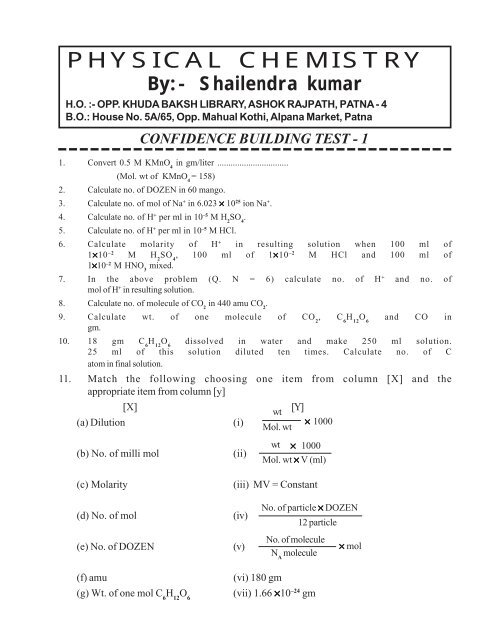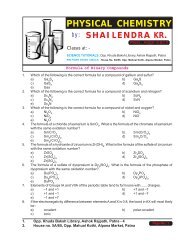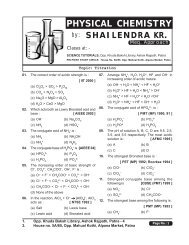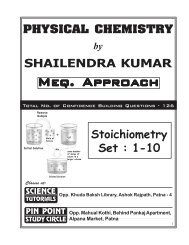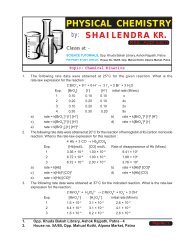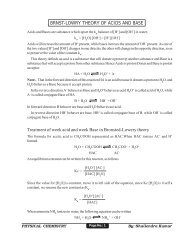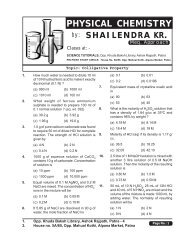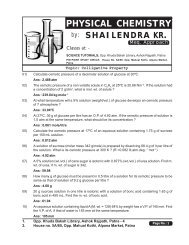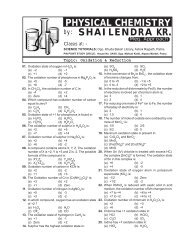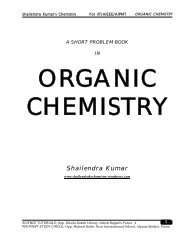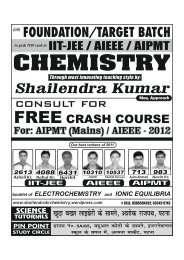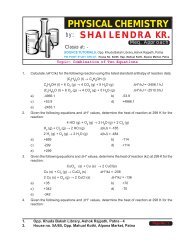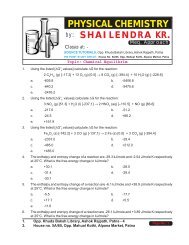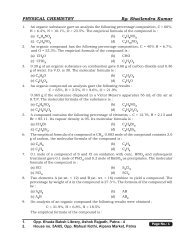Mole Concept Confidence building test - Shailendra Kumar Chemistry
Mole Concept Confidence building test - Shailendra Kumar Chemistry
Mole Concept Confidence building test - Shailendra Kumar Chemistry
Create successful ePaper yourself
Turn your PDF publications into a flip-book with our unique Google optimized e-Paper software.
PHYSICAL CHEMISTRYBy:- <strong>Shailendra</strong> kumarH.O. :- OPP. KHUDA BAKSH LIBRARY, ASHOK RAJPATH, PATNA - 4B.O.: House No. 5A/65, Opp. Mahual Kothi, Alpana Market, PatnaCONFIDENCE BUILDING TEST - 11. Convert 0.5 M KMnO 4in gm/liter ................................(Mol. wt of KMnO 4= 158)2. Calculate no. of DOZEN in 60 mango.3. Calculate no. of mol of Na + in 6.023 × 10 25 ion Na + .4. Calculate no. of H + per ml in 10 –5 M H 2SO 4.5. Calculate no. of H + per ml in 10 –5 M HCl.6. Calculate molarity of H + in resulting solution when 100 ml of1×10 –2 M H 2SO 4, 100 ml of 1×10 –2 M HCl and 100 ml of1×10 –2 M HNO 3mixed.7. In the above problem (Q. N = 6) calculate no. of H + and no. ofmol of H + in resulting solution.8. Calculate no. of molecule of CO 2in 440 amu CO 2.9. Calculate wt. of one molecule of CO 2, C 6H 12O 6and CO ingm.10. 18 gm C 6H 12O 6dissolved in water and make 250 ml solution.25 ml of this solution diluted ten times. Calculate no. of Catom in final solution.11. Match the following choosing one item from column [X] and theappropriate item from column [y][X]wt[Y](a) Dilution(i)× 1000Mol. wt(b) No. of milli mol(ii)wt × 1000Mol. wt × V (ml)(c) Molarity(iii) MV = Constant(d) No. of mol(iv)No. of particle × DOZEN12 particle(e) No. of DOZEN(v)No. of moleculeN Amolecule× mol(f) amu(g) Wt. of one mol C 6H 12O 6(vi) 180 gm(vii) 1.66 ×10 –24 gm
CONFIDENCE BUILDING TEST - 21. Give the number of moles of each element present in 1.0mol of each of the following substances:(a) NH 3(b) N 2H 4(c) (NH 4) 2Cr 2O 7(d) CoCl 2. 6H 2O2. How many atoms of each element are present in 1.0 molof each of the substances in Ques. no 1?3. How many grams of each element are present in 1.0 molof the substances in Question no. 1?4. How many moles of each element are present in 1.0 molof the substances in Question no. 1?5. How many atoms of each element are present in 1.0 molof the substances in Question no. 1?6. Determine the mass in grams of :(a) 3.00 × 10 20 N 2molecules(b) 3.00 × 10 –3 mol of N 2(c) 1.5 × 10 2 mol of N 2(d) a single N 2molecule7. Aluminum metal is produced by passing an electriccurrent through a solution of aluminum oxide (Al 2O 3)dissolved in molten cryolite (Na 3AlF 6). Calculate themolecular weights of Al 2O 3and Na 3AlF 6.8. Ascorbic acid, or vitamin C (C 6H 8O 6), is an essentialvitamin. It cannot be stored by the body and must bepresent on the diet. What is the molecular weight ofascorbic acid? Vitamin C tablets are often taken as adietary supplement. If a typical tablet contains 500.0 mgof vitamin C, how many moles and how many moleculesof vitamin C does it contain?9. How many moles are represented by each of thesesamples?(a) 100 molecules (exaclty) of H 2O(b) 100.0 g of H 2O(c) 500 atoms (exactly) of Fe(d) 500.0 g of Fe(e) 150 molecules (exactly) of O 2(f) 150.0 g of Fe 2O 310. Aspartame is an artificial sweetener that is 160 timessweeter than sucrose (table sugar) when dissolved inwater. It is marked as Nutra-Sweet. The molecular formulaof aspartame is C 14H 18N 2O 5.(a) Calculate the moleculer weight of aspartame.(b) How many moles of molecules are in 10.0 g ofaspartame?(c) What is the mass in grams of 1.56 mol ofaspartame.(d) How many molecules are in 5.0 mg ofaspartame?(e) How many atoms of nitrogen are in 1.2 g ofaspartame?(f) What is the mass in grams of 1.0 × 10 9molecules of aspartame?(g) What is the mass in grams of one molecule ofaspartame?11. The molecular formula of acetylsalicylic acid (aspirin),one of the most commonly used pain relievers, is C 9H 8O 4.(a) Calculate the molecular weight of aspirin.(b) A typical aspirin tablet contains 500 mg of C 9H 8O 4.How many moles of C 9H 8O 4molecules and how manymolecules of acetyl salicylic acid are in a 500-mg tablet?12. Chloral hydrate (C 2H 3Cl 3O 2) is a drug that is used assedative and hypnotic.(a) Calculate the molecular weight of chloralhydrate.(b) How many moles of C 2H 3Cl 3O 2molecules arein 500.0 g of chloral hydrate?(c) What is the mass in grams of 2.0 × 10 –2 mol ofchloral hydrate?(d) How many chlorine atoms are in 5.0 g of chloralhydrate?(e) What mass of chloral hydrate would contain1.0 g of Cl?(f) What is the mass of exactly 500 molecules ofchloral hydrate?13. Calculate the molecular weight of each of the followingsubstances:(a) CuCl 2.6H 2O (The .6H 2O indicates thepresence of six water molecules.)(b) NaBrO 3(c) (C 2F 4) 500(the polymer Teflon), which is madeof the unit :F F–C – C–F F14. How many atoms of carbon are present in 1.0 g of eachof the following?(a) CH 4O(b) CH 3CO 2H(c) Na 2CO 3
15. Vitamin B 12, cyanocobalamin, is essential for humannutrition. It is concentrated in animal tissue but not inhigher plants. Although nutritional requirements for thevitamin are quite low, people who abstain completelyfrom animal products may develop a deficiency anemia.Cyanocobalamin is the form used in vitamin supplements.It contains 4.34% cobalt by mass. Calculate the molecularweight (molar mass) of cyanocobalamin assuming thereis one atom of cobalt in every molecule ofcyanocobalamin.16. Hemoglobin is the protein that transports oxygen inmammals. Hemoglobin is 0.342% Fe by mass, and eachhemoglobin molecules contains four iron atoms.Calculate the molecular weight (molar mass) ofhemoglobin.17. A student prepares a solution by dissolving 4.75 g ofsolid KOH in enough water to make 275 mL of solution.(a) Calculate the molarities of the major ionic speciespresent. (b) Calculate the molarities of the major ionicspecies present if 25.00 mL of this solution is added to a100-mL volumetric flask and water us added to the mark.18. What species are present in solution when the followingcompounds are dissolved in water? (a) ammoniumsulfate; (b) Carbon dioxide: (c) sodium fluoride; (d)potassium carbonate; (e) sodium hydrogensulfate; and(f) chlorine.19. Aqueous solutions of potassium permanganate are oftenused in general chemistry laboratories. A laboratoryinstructor weighed out 474.1 g of KMnO 4, added thesolid to a 2.00-L volumetric flask, and filled to the markwith water. A 50.00-mL sample was removed from thevolumentric flask and mixed with enough water to make1.500 L of solution. What was the final molarity of theKMnO 4solution?20. Vitamin B 12is a large molecule called cobalamin. There isone atom of cobalt in each molecule of vitamin B 12, andthe mass percent of cobalt is 4.34%. Calculate the molarmass of cobalamin.21. A worker in a biochemistry laboratory needed a solutionthat was 0.30 M in sodium acetate (NaCH 3CO 2) and 0.15M in acetic acid (CH 3CO 2H). On hand were stocksolutions of 5.0 M solution acetate and 5.0 M aceticacid. Describe how the worker prepared 1.5 L of thedesired solution.22. The density of pure water is 1.0 g/mL. Calculate the molarconcentration of water molecules in pure water.23. Plants can be badly damaged by solutions that are highlyconcentrated. A biochemist friend of the urban gardenerrecommends against using fertilizer solution that aregreater than 1.0 mM (1.0 × 10 –3 M) in total nitrogen. Ifthe gardener wants to prepare 750 mL of 1.0 mM fertilizersolution, how many milliliters of the stock solution willbe need to make the desired solution?24. When aqueous solutions are used for intravenousinfusions, it is essential that the molarity of the solutionmatch the molarity of blood. Blood is approximately 0.31M, so a solution of sodium chloride for infusion, calledsaline, must have a concentration of 0.155 M. Calculatethe mass of NaCl that solution be used to prepare 5.00 Lof a 1.00 M stock solution, and then calculate how manymilliliters of the resulting stock solution must be dilutedto give 455 mL of 0.155 M solution for infusion.Solution1. (a) 1.0 mol N; 3.0 mol H;(b) 2.0 mol N; 4.0 mol H;(c) 2.0 mol N; 8.0 mol H; 2.0 mol Cr; 7.0 mol O;(d) 1.0 mol Co; 2.0 mol Cl; 12 mol H; 6.0 mol O;2. (a) 6.0 × 10 23 atoms N; 18 × 10 24 atoms H;(b) 1.2 × 10 24 atoms N; 2.4 × 10 24 atoms H;(c) 1.2×10 24 atoms N; 48×10 24 atoms H;1.2×10 24 atoms Cr; 4.2×10 24 atoms O;(d) 6.0 × 10 23 atoms Co; 1.2 × 10 24 atoms Cl; 7.2 × 10 24 atoms H;3.6 × 10 24atoms O;3. (a) 14 g N; 3.0 g H; (b) 28 g N; 4.0 g H;(c) 28 g N; 8.0 g H; 1.0 × 10 2 g Cr; 1.1 × 10 2 g O;(d) 59 g Co; 71 g Cl; 12 g H; 96 g O;4. (a) 5.9 × 10 –2 mol N; 1.8 × 10 –1 mol H;(b) 6.3 × 10 –2 mol N; 1.3 × 10 –1 mol H;(c) 7.9 × 10 –3 mol N; 3.2 × 10 –2 mol H; 7.9 × 10 –3 mol Cr;2.8 × 10 –2 mol O;(d) 4.2×10 –3 mol Co; 8.4×10 –3 mol Cl; 5.0 × 10 –2 mol H; 2.5 × 10 –2 mol O;5. (a) 3.5 × 10 22 atoms N; 1.1 × 10 23 atoms H;(b) 3.8 × 10 22 atoms N; 7.5 × 10 22 atoms H;(c) 4.8 × 10 21 atoms N; 1.9 × 10 22 atoms H; 4.8 × 10 21 atoms Cr; 1.7 × 10 22atoms O;(d) 2.5 × 10 21 atoms Co; 5.1 × 10 21 atoms Cl; 3.0 × 10 22 atoms H; 1.5 ×10 22 atoms O;6. (a) 1.40 × 10 –2 g N 2; (b) 8.40 × 10 –2 g N 2; (c) 4.2 × 10 3 g N 2;(d) 4.65 × 10 –23 g N 2;7. Al 2O 3, 102.0 g/mol; Na 3AlF 6; 210.0 g/mol;8. 2.841 × 10 –3 mol; 1.711 × 10 21 molecules;9. (a) 1.66 × 10 –22 mol (100 is exact) (b) 5.549 mol;(c) 8.30 × 10 –22 mol (500 is exact)(d) 8.953 mol;(e) 2.49 × 10 –22 mol (150 is exact)(f) 0.9393 mol;10.(a) 294 g/mol (b) 3.40 × 10 –2 mol; (c) 459 g;(d) 1.0 × 10 19 molecules (e) 4.9 × 10 21 atoms of nitrogen;(f) 4.9 × 10 –13 g or 490 fg; (g) 4.88 × 10 –13 g/molecule11. (a) 180.0 g/mol; (b) 3 × 10 –3 mol; 2 × 10 21 molecules;12.(a) 165.4 g/mol; (b) 3.023 mol; (c) 3.3 g (d) 5.5 × 10 22 atoms of chlorine(e) 1.6 g chloral hydrate (f) 1.373 × 10 –19 g13.(a) 242.5 g/mol (b) 150.9 g /mol (c) 5.0 × 10 4 g/mol14.(a) 1.9 × 10 22 atoms of C; (b) 2.0 × 10 22 atoms (c) 5.7 × 10 21 atoms15. 1360 g/ mol16. 65497 g/mol17. (a) [K + ] = [OH – ] = 0.308 M (b) [K + ] = [OH – ] = 0.077 M–218. (a) H 2O, NH 4+, SO 4(b)H 2O,CO 2(c) H 2O, Na + , F – (d) H 2O, K + –2, CO 3,(e) H 2O, Na + , HSO – 4, (f) H 2O, Cl 219. 5 × 10 –2 M20. 1.36 × 10 3 g/mol21. Mix 0.090 L of sodium acetate solution, 0.045 liter of acetic acidsolution and enough water to make the final volume 1.5 liter22. 55.55 M23. 1.2 mL24. 292 g , 7.5 mL
CHEMISTRYBy:- <strong>Shailendra</strong> <strong>Kumar</strong>H.O. :- OPP. KHUDA BAKSH LIBRARY, ASHOK RAJPATH, PATNA - 4B.O.: House No. 5A/65, Opp. Mahual Kothi, Alpana Market, PatnaCONFIDENCE BUILDING TEST-31. Which of the following is correct ?(a) 1 L = 1 dm 3 (b) 1 L = 10 dm 3(c) 10 L = 1 dm 3 (d) 1 L = 1 m 32. 5.6 litres of a gas at N.T.P are found to have amass of 11 g. The molecular mass of the gas is(a) 22 (b) 44(c) 88 (d) 323. How many atoms are present in a mole of H 2SO 4?(a) 3 × 6.02 × 10 23 (b) 5 × 6.02 × 10 23(c) 6 × 6.02 × 10 23 (d) 7 × 6.02 × 10 234. The total number of electrons present in 18 ml ofwater (density of water is 1 g ml –1 ) is(a) 6.02 × 10 23 (b) 6.02 × 10 26(c) 6.02 × 10 24 (c) 6.02 × 10 255. If 10 21 molecules are removed from 200 mg of CO 2,then the number of moles of CO 2left are(a) 2.88 × 10 –3 (b) 28.8 × 10 –3(c) 0. 288 × 10 –3 (d) 6.02 × 10 –26. Number of molecules in 100 ml of each of O 2, NH 3and CO 2at STP are(a) in the order CO 2< O 2< NH 3(b) in the order NH 3< O 2< CO 2(c) the same(d) NH 3= CO 2< O 27. A gas is found to have the formula (CO) x. Its V.D.is70. The value of x must be(a) 7 (b) 4(c) 5 (d) 68. 1 mol of CH 4contains(a) 6.02 × 10 23 atoms of H(b) 4 g atoms of hydrogen(c) 1.81 × 10 23 molecules of CH 4(d) 3.0 g of carbon9. Which one of the following pairs of gases containsthe same number of molecules ?(a) 16 g of O 2and 14 g of N 2(b) 8 g of O 2and 22 g of CO 2(c) 28 g of N 2and 22 g of CO 2(d) 32 g of O 2and 32 g of N 210. The number of water molecules in 1 litre of wateris(a) 18 (b) 18 × 1000(c) N A(d) 55.55 N A11. The number of oxygen atoms in 4.4 g of CO 2isapprox.(a) 1.2 × 10 23 (b) 6 × 10 22(c) 6 × 10 23 (d) 12 × 10 2312. A 5 molar solution of H 2SO 4is diluted from be1 litre to a volume of 10 litres, the normality of thesolution will be:(a) 1 N(b) 0.1 N(c) 5 N(d) 0.5 N13. The number of moles of BaCO 3which contains 1.5moles of oxygen atoms is(a) 0.5 (b) 1(c) 3 (d) 6.02 × 10 2314. The total number of protons in 10 g of calciumcarbonate is (N 0= 6.023 × 10 23 )(a) 1.5057 × 10 24 (b) 2.0478 × 10 24(c) 3.0115 × 10 24 (d) 4.0956 × 10 2415. If N Ais Avogadro’s number then number of valenceelectrons in 4.2 g of nitride ions (N 3– ) is(a) 2.4 N A(b) 4.2 N A(c) 1.6 N A(d) 3.2 N A16. Haemoglobin contains 0.33% of iron by weight. Themolecular weight of haemoglobin is approximately67200. The knumber of iron atoms (at. wt. ofFe = 56) present in one molecule of haemoglobin is(a) 6 (b) 1(c) 4 (d) 217. 250 ml of a sodium carbonate solution contains 2.65grams of Na 2CO 3. If 10 ml of this solution is dilutedto one litre, what is the concentration of the resultantsolution ? (mol. wt. of Na 2CO 3= 106)(a) 0.1 M(b) 0.001 M(c) 0.01 M(d) 10 –4 M18. The number of moles of SO 2Cl 2in 13.5 g is(a) 0.1 (b) 0.2(c) 0.3 (d) 0.4
19. The number of atoms in 4.25 g of NH 3isapproximately(a) 1 × 10 23 (b) 1.5 10 23(c) 2 × 10 23 (d) 6 × 10 2320. Which has maximum molecules ?(a) 7 g N 2 (b) 2 g H 2(c) 16 g NO 2(d) 16 g O 221. A compound has haemoglobin like structure. It hasone Fe. It contains 4.6% of Fe. The approximatemolecular mass is(a) 100 g mol –1 (b) 1200 g mol –1(c) 1400 g mol –1 (d) 1600 g mol –122. Which has maximum number of atoms ?(a) 24 g of C (12)(b) 56 g of Fe (56)(c) 27 g Al (27)(d) 108 g of Ag (108).23. Calculate kb of Cl – (Assume ka of HCl is 10 7 )(a) 10 –7 (b) 10 14(c) 10 21 (d) 10 –2124. Concentration of H + in 10 –7 M HCl solution isapproximetely(a) 2 × 10 –7 M (b) 10 –7 M(c) 10 –14 M (d) 10 –8 M25. Which two of the following solution contains equalpH.(1) 50 ml of 0.10 M HCl + 25 ml H 2O(2) 50 ml of 0.10 M HCl + 50 ml H 2O(3) 50 ml of 0.10 M H 2SO 4+ 25 ml H 2O(4) 25 ml of 0.10 M H 2SO 4+ 50 ml H 2O(a) (1) and (4) (b) (1) and (3)(c) (1) and (2) (d) (2) and (3)26. If 40 ml of 1.6 M HCl and 60 ml of 2.0 M NaOHare mixed, What are the molar concentrations ofNa + .(a) 0.640 M (b) 1.2 M(c) 0.560 M (d) 0.65 M27. Calculate no of millimol of CO 2in 5.6 liter CO 2atS.T.P(a) 200 (b) 250(c) 1000 (d) 10028. Kb of acetate ion (CH 3COO – ) is ......Ka of acetic acid is 1.8 × 10 -5(a) 1.8 × 10 9 (b) 1.8 × 10 +5(c) 5.6 × 10 4 (d) 5.6 × 10 –1029. Predict the nature of solution is Acidic, Basic orNeutral in following soution of ions.(a) Na + (b) CH 3COO –(c) Cl – +(d) NH 4(e) K + –(f) NO 330. Calculate weight of oxygen atom in 6.023 × 10 24atom oxygen(a) 16 gm(b) 32 gm(c) 160 gm(d) 1600 gm31. Which of the following reaction explain the basicnature of sodium acetate (CH 3COONa)(a) CH 3COONa + H 2O CH 3COOH + NaOHWeek acid Strong base(b) CH 3COONa100%CH 3COO + Na +Na + + H 2O No reaction (No Hydrolysis)CH 3– COO – + H 2O CH 3COOH+OH –(c) Na+ + H 2O NaOH + H 2(d) CH 3COO – + H + CH 3COOH32. 9.8 gm H 2SO 4dissolved in water and make250 mL solution, molarity of 25 ml of this solution is(a) 0.004 M(b) 0.04 M(c) 0.4 M(d) 0.024 M33.Which of the following is correct representation of+K NH3. (Assume pure NH 3self ionizes into NH 4and NH 2–)(a) K NH3= [NH 3] [NH 2–](b) K NH3= [NH 4+] [NH 2–](c) K NH3= [NH 2–] [NH 2–](d) K NH3= [NH 3] [NH 3]34. What is the total concentration of Cl – in a mixturethat is 0.20 M MgCl 2, 0.30 M NaCl and 0.40 MAlCl 3.(a) 0.30 M(b) 0.90 M(c) 2.80 M(d) 1.90 M35. How many moles of Ca(OH) 2are present in 350ml of 0.010 M aqueous solution of Ca(OH) 2(a) 35 (b) 3.5(c) 0.0035 (d) 0.03536. In problem (35) what is the molar concentration ofHydroxide ion(a) Zero(b) 0.010 M(c) 0.021 M(d) 0.0070 M37. What volume of 0.040 M aqueous HCl solutionwould be required to entirely neutralize the solutionin 350 ml of 0.010 M aqueous solution of Ca(OH) 2.(a) 175 ml(b) 75 ml(b) 350 ml(d) 700 ml
A N S W E R S1. (a) 2. (b) 3. (d) 4. (c) 5. (a)6. (c) 7. (c) 8. (b) 9. (a) 10. (d)11. (a) 12. (a) 13. (a) 14. (c) 15. (a)16. (c) 17. (b) 18. (a) 19. (d) 20. (b)21. (b) 22. (a) 23. (d) 24. (a) 25. (a)26. (b) 27. (b) 28. (d)29. (a) Neutral (b) Basic (c) Neutral (d) Acidic (e) Neutral (f) Neutral30. (c) 31. (b) 32. (c) 33. (b) 34. (d)35. (c) 36. (d) 37. (a)
CHEMISTRYBy:- <strong>Shailendra</strong> <strong>Kumar</strong>H.O. : Opp. Khuda Baksh Library, Ashok RajPath, Patna -4B.O.: House No. 5A/65, Opp. Mahual Kothi, Alpana Market, Patna<strong>Confidence</strong> Building Test - 41. How many moles of calcium hydroxide are presentin 350 mL of a 0.010 M aqueous solution of Ca(OH) 2?(a) 35(b) 3.5(c) 0.010(d) 0.0035(e) 10.02. In Problem 1, what is the molar concentrration ofthe hydroxide ion?(a) zero(b) 0.010 M(c) 0.021 M(d) 0.0050 M(e) 0.0070 M3. What volume of 0.040 M aqueous HCl solution wouldbe required to entirely neutralize the solution inProblem 1?(a) 43.75 mL(b) 87.5 mL(c) 175 mL(d) 350 mL(e) 700 mL4. Suppose 100 mL of 0.020 M aqueous H 3PO 4areadded to the solution in Problem 1. Assuming theolumes are additive, what are the concentrations ofOH – species present after reaction?(a) zero(b) 0.0022 M(c) 0.0011 M(d) 0.005 M(e) 1.11×10 –65. Which of the following would be a satisfactory primarystandard for titrating a solution of HCl (aq)?(a) NaOH(b) Na 2CO 3(c) KHP(d) HNO 3(e) HAc6. In standardizing a solution of NaOH (aq) of unknownconcentration, 15.75 mL of it are required to reachthe neturalization point in a reaction with 0.3500grams of KHP (MW = 204.2 g/mol). What is the molarconcentration of NaOH?(a) 0.1088 M(b) 1.11 × 10 –4 M(c) 0.022 M(d) 22.2 M7. Identify the INCORRECT statement:(a) One equovalent of a substance has 1 mole ofreactive capability(b) The equivalent weight of a substance is the gramsof that substance in one equivalent(c) One mole of HCl is also one equivalent of HCl(d) An equivalent of acid exactly neutralizes anequivalent of base(e) The Normality of a solution is the number ofequivalents per mole of that solution8. Identify the INCORRECT statement:(a) 24.5 grams of H 2SO 4is 1/2 of an equivalent ofH 2SO 4(b) A 0.100 N solution of Ca(OH) 2is 0.050 M(c) The equivalent weight of Ca(OH) 2is 74 g/equiv.(d) A 6.0 M solution of H 3PO 4is 18.0 N9. What is the normality of an H 2SO 4solution if10.0 mL of it exactly neutralizes 100.0 mL of 2.0 Nsodium hydroxide solution?(a) 0.10 N(b) 0.20 N(c) 10.0 N(d) 20.0 N10. What is the H 3O + concentration in 1.0 M NaOH?(a) 1.0 M(b) 1.0 × 10 –14 M(c) 1.0 × 10 14 M(d) 1.0 × 10 –7 M11. What is the OH – concentration in a neutral aqueoussolution?(a) exactly zero
(b) 1.0 × 10 –14 M(c) 7.0 M(d) 1.0 M(e) 1.0 × 10 –7 M12. A particular vinegar solution has a H 3O + concentrationof 0.015 M. What is the pH the solution(a) 1.8(b) 1.8(c) 0.015 M(d) 3.3(e) 3.313. What is the pOH of the solution in problem 12?(a) 10.7(b) 17.3(c) 12.2(d) 15.8(e) 7.014. The Ka of acetic acid is 1.8 × 10 –5 . What is its pKa?(a) 1.8 × 10 –5(b) 5.18(c) 4.74(d) 4.7415. What is the pH of a 0.100 M solution of acetic acid?(a) 1.34 × 10 –3(b) 2.87(c) 1.00(d) 4.74(e) 3.7416. What is the acetate ion (Ac – or CH 3COO – )concentration of the solution in Problem 15?(a) exactly zero(b) 3.74 M(c) 0.100 M(d) 1.34 × 10 –3(e) 1.8 × 10 –617. What is the percent ionization of the acetic acid inProblem 15?(a) 1.34 %(b) 0.134%(c) 0.0014%(d) 1.8 × 10 –5 %(e) 1.8 × 10 –3 %+19. What is the NH 4concentration of the solution inProblem 18?(a) 6.0 M(b) 0.0104 M(c) 1.8 × 10 –4 M(d) 1.8 × 10 –4 M20. HNO 2has a pK a= 3.35 and HOCl has a pK a= 7.45.Which is the stronger acid?(a) HNO 2(b) HOCl21. Based on the information given in Problem 20, whatis the K aof HNO 2?(a) 5.25 × 10 –1(b) 2.24 × 10 3(c) 3.5 × 10 –3(d) 4.46 × 10 –4(e) 1.8 × 10 –522. What is the H 2O species concentration in any diluteaqueous solution?(a) zero(b) infinite(c) 55.5 M(d) 1.0 M(e) 1.0 × 10 –7 M23. Which is the most likely pH of Windex glass cleaner?(a) 2(b) 4(c) 7(d) 12(e)1418. What is the pH of 6.0 N aqueous solution of NH 3(ammonia). It’s K b= 1.8 × 10 –5 .(a) 0.0104 (c) 0.778 (e) 13.2(b) 1.98 (d) 12.0
A N S W E R S1. d2. c3. c4. b5. b6. a7. e8. c9. d10. b11. e12. a13. c14. c15. b16. d17. a18. d19. b20. a21. d22. c23. d
Code :- 05CHEMISTRYBy:- <strong>Shailendra</strong> <strong>Kumar</strong>H.O. :- Opp. Khuda Baksh Library, Ashok RajPath, Patna -4B.O.:- House No. 5A/65, Opp. Mahual Kothi, Alpana Market, Patna<strong>Confidence</strong> Building Test 051. What is the total concentration of Cl – in a mixturethat is 0.20 M MgCl 2, 0.30 M NaCl and 0.40 M AlCl 3.(a) 0.30 M(b) 0.90 M(c) 2.80 M(d) 1.90 M2. How many moles of Ca(OH) 2are present in 350 mlof 0.010 M aqueous solution of Ca(OH) 2(a) 35 (b) 3.5(c) 0.0035 (d) 0.0353. In problem (2) what is the molar concentration ofHydroxide ion(a) Zero(b) 0.010 M(c) 0.021 M(d) 0.0070 M4. What volume of 0.040 M aqueous HCl solution wouldbe required to entirely neutralize the solution in 350ml of 0.010 M aqueous solution of Ca(OH) 2.(a) 175 ml(b) 75 ml(b) 350 ml(d) 700 ml5. Suppose 100 ml of 0.020 M aqueous H 3PO 4are addedto the solution of 350 ml of 0.010 M aqueous solutionof Ca(OH) 2. Assume the volumes are additive, whatare the concentrations of OH – species present afterreaction.(a) 1/450 M(b) 1/350 M(c) 13/450 M(d) 6/450 M6. Identify the incorrect statement(a) One equivalent of substance has one mol ofreactive capability(b) The equivalent weight of a substance is the gramof that substance in one equivalent(c) One mol of HCl is also one equivalent of HCl(d) The normality of a solution is the number ofequivalents per mole of that solution7. Identify the incorrect statement(a) 24.5 gm of H 2SO 4is 0.5 of an equivalent of H 2SO 4(b) 0.10 N solution of Ca(OH) 2is 0.050 M(c) The equivalent weight of Ca(OH) 2is 74 gm/equivalent(d) A 6.0 M solution of H 3PO 4is 18.0 N8. What is the normality of an H 2SO 4solution if 10.0 mlof it exactly neutralizes 100 ml of 2.0 N sodiumhydroxide solution.(a) 0.10 N(b) 0.20 N(c) 10.0 N(d) 20.0 N9. What is the H 3O + concentration in 1.0 M NaOH ?(a) 1.0 M(b) 1.0 × 10 –14 M(c) 1.0 × 10 14 M(d) 1.0 × 10 –7 M10. What is the OH – concentration in a neutral solution.(a) exactly zero(b) 1.0 × 10 –14 M(c) 7.0 M(d) 1.0 × 10 –7 M11. The K aacetic acid is 1.8 × 10 –5 , what is its Pk a?(log 1.8 = 0.26)(a) 1.8 × 10 –5 (b) 5.18(c) 4.74 (d) 9.2612. What is the pH of 0.10 M solution of acetic acid(K aof acetic acid = 1.8 × 10 –5 )(a) 1.34 × 10 –3 (b) 2.87(c) 4.74 (d) 3.7413. What is the percent ionization of the 0.18 M aceticacid (K a= 1.8 × 10 –5 )(a) 4% (b) 1%(c) 0.01% (d) 0.001%14. What is P OHof 10 –2 M CH 3–COO –Pk aof acetic acid = 5(a) 5.5 (b) 8.5(c) 7.0 (d) 215. What is the percent hydration of 0.1 M acetate ionPk aof acetic acid = 5(a) 10 –3 % (b) 10 –2 %(c) 10 –4 % (d) 10 –5 %16. What volume of 0.15 M HCl can be made from7.5 ml of concentrated HCl (12 M)(a) 0.060 L(b) 6.0 L(c) 0.60 L(d) 6.0 × 10 2 L17. How many moles of Mg(OH) 2can be precipitatedwhen 100 ml of 0.5 M MgCl 2solution is mixed with100 ml of 0.25 M KOH.(a) 0.025 mol(b) 0.05 mol
(c) 0.0125 mol(d) 0.5 mol18. The first step in the ostwald process for producingnitric acid, HNO 3from ammonia is represented bythis equation4NH 3(g) + 5O 2(g) → 4NO (g) + 6H 2O (g)What volume of oxygen is needed to produce eachliter of NO?(a) 0.80 L(b) 5.0 L(c) 1.25 L(d) 22.4 L19. What volume of 0.500 M CaCl 2solution is needed toprepare 250 ml of solution that has a chlorideconcentration of 0.100 M(a) 12.5 ml(b) 50 ml(c) 25 ml(d) 100 ml20. The limiting reagent in a particular reaction can berecognized because it is the reagent(a) with the smallest coefficient in the balancedequation(b) that has the lowest mass in the reaction mixture(c) that is present in the smallest molar quantity(d) that would be used up first21. How many gram of carbon are present in 0.50 molof sucrose (C 12H 22O 11)(a) 60 gm(b) 72 gm(c) 90 gm(d) 120 gm22. The major commercial source for bromine is deepbrine well where the concentration of bromide ioncan be high as 5000 ports per million by mass. Whatis this concentration when expressed as a masspercentage?(a) 0.005% (b) 0.5 %(c) 0.05% (d) 5%23. The pH of a 0.005 M aqueous solution of sulphuricacid is approximately:(a)0.005 (b) 2(c) 1 (d) 0.0124. The pH of a 10 –10 NaOH solution is approximately:(a) 10 (b) 7(c) 1(d)1425. If the dissociation constant of an acid HA is 1 × 10 –5 ,the pH of a 0.1 M solution of the acid HA will beapproximately:(a) 3 (b) 5(c) 1 (d) 626. The pH of a solution is 5.0. To this solution sufficientacid is added to decrease the pH to 2.0. The increasein hydrogen ion concentration is :(a) 1000 times (b) 5/2(c) 100 times(d) 5 times27. When the pH of a solution is 2 the hydrogen ionconcentration is :(a) 1 × 10 –14 M(b) 1 × 10 –2 M(c) 1 × 10 –7 M(d) 1 × 10 –12 M28. The pH of 1/1000 N KOH solution is :(a) 10 –11 (b) 3(c) 2 (d) 1129. Assuming complete dissociation the pH of a 0.01 MNaOH solution is equal to :(a) 2.0 (b) 14.0(c) 12.0 (d) 0.0130. The pH of the solution obtained by mixing 10 mL of10 –1 N HCl and 10 mL of 10 –1 N NaOH is:(a) 8 (b) 2(c) 7(d) None31. Which addition would not change the pH of 10 mL ofdilute hydrochloric acid :(a) 20 mL of the same dilute hydrochloric acid(b) 5 mL of pure water(c) 10 mL of pure water(d) 10 mL of concentrated hydrochloric acid32. 10 mL of a solution contains 0.1 M NH 4Cl + 0.01 MNH 4OH. Which addition would not change the pH ofthe solution:(a) Adding 1 mL water(b) Adding 5 mL of 0.1 M NH 4Cl(c) Adding 5 mL of 0.1 M NH 4OH(d) Adding 10 mL of 0.1 M NH 4Cl33. At 90°C, pure water has [H 3O + ] = 10 –6 mol/litre.The value of K wat 90°C is:(a) 10 –6 (b) 10 –12(c) 10 –14 (d) 10 –834. The pH of 10 –2 N HCl would be approximately:(a) 1 (b) 1.5(c) 2 (d) 2.535. 0.4 g NaOH present in one litre solution shows thepH :(a) 12 (b) 2(c) 6 (d) 1036. pH of a 10 –8 M solution of HCl in water is(a) 8(b) –8(c) Between 7 and 8(d) Between 6 and 7
A N S W E R S1. d 32. a2. c 33. b3. c 34. c4. a 35. a5. a 36. d6. d7. c8. d9. b10. d11. c12. b13. b14. a15. b16. c17. c18. c19. c20. d21. b22. b23. b24. b25. a26. a27. b28. d29. c30. c31. a


